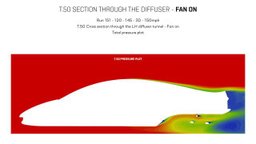Gordon Murray Automotive T.50

Gordon Murray Automotive T.50
Gordon Murray Automotive T.50 is a car designed by Gordon Murray, designer of the McLaren F1. It revives the F1's signature delta-formation three-seater layout, with power from a new 3.9-liter naturally aspirated Cosworth V-12 producing 650 hp and revving to 12,100 rpm.[1]
Features
The T.50 has a rear-mounted fan like the Brabham BT46B Formula 1 car, designed by Murray in 1978. The T.50's fan is electric, which allows for infinitely variable speed, something the Brabham was not capable of.[1]
The fan on the T.50 is used for boundary layer control, managing the airflow above and beneath the car.
"As designers and aerodynamicists, we'd all love to have very steep, aggressive diffusers at the back of the car to expand the air, and therefore, accelerate the air underneath and get more ground effect," Murray explained.
"Unfortunately, air has a mind of its own, and it'll only follow a certain profile before it stalls and breaks away from the surface and causes a vortex, or a series of vortices."[1]
"We've done the ideal, very steep, aggressive, diffuser...
We have strategically-placed slots in that surface," he said.
"What we do when the fan fires up, and we want more downforce at lower speeds, is we open the slots and spool the fan up to maximum, and we remove all the dirty air and the boundary layer, and that means that the air has to follow the surface.
It's forced to follow the surface to fill the vacuum that was left there."[1]
The remaining four modes are driver selected.
High-downforce mode increases downforce by 30 percent.
Streamline mode reduces drag by 10 percent, by closing the underbody ducts and spinning the fan up to high speed.
V-max mode combines Streamline aero mode with a 30-hp boost from the engine's mild-hybrid system that can last for three minutes.
Test mode that demonstrates the capabilities of the system at a standstill to make sure everything is working.[1][3]
The system has no big wings or other unsightly aero devices.
It is also very lightweight.
The T.50 is expected to come in at 980 kg.[1]


